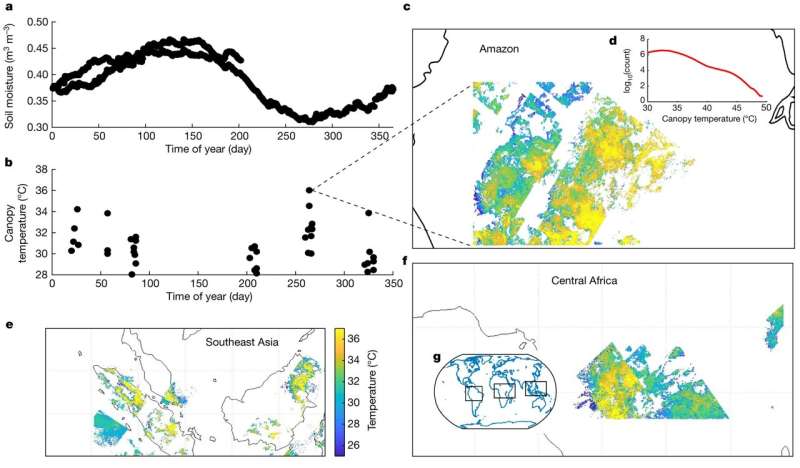This article has been reviewed according to Science X's editorial process and policies. Editors have highlighted the following attributes while ensuring the content's credibility:
fact-checked
peer-reviewed publication
trusted source
proofread
Tropical forests may be approaching a critical high-temperature threshold

After July 2023 was confirmed as the warmest month on record for planet Earth, a new study has shown the world's tropical forest canopies may be closer to critical high-temperature thresholds than previously known.
The research, published in Nature, combines high-resolution data from a thermal imaging instrument on the International Space Station and in situ warming experiment data from across the world's tropical forests.
It demonstrates for the first time that a small percentage of tropical leaves are already reaching, and occasionally exceeding, the temperatures at which they can no longer function. It also suggests that as climate change continues, entire canopies could die.
The study was carried out by an international team of researchers including Dr. Sophie Fauset, Associate Professor in Terrestrial Ecology at the University of Plymouth.
They say their findings have serious implications because tropical forests are home to most of the world's biodiversity and are key regulators of our climate.
For the study, Dr. Fauset—who has carried out work to assess leaf temperatures from the UK to Brazil, West Africa and China—contributed data showing that individual leaves could reach up to 18°C above air temperature in a Brazilian montane forest.
"Trees are a critical part of our planet's response to climate change, and tropical forests play a key role in housing species diversity and regulating the planet's climate. If they are damaged by increases in temperatures, we are losing a key line of defense and limiting nature's ability to mitigate the impacts of human activity. Other research I have been involved in has looked at the sensitivity of tropical forests to climate, and shown that tree carbon stock is reduced at maximum temperatures above 32°C during the hottest part of the year. If we don't do more to address climate change, the consequences could be severe," says Fauset.
In the current study, researchers were able to build a comprehensive understanding of current tropical forest leaf temperatures and model how they may be expected to change given ongoing anthropogenic global warming.
Among the key results was an estimation of the proportion of leaves that may approach critical temperatures under future increases in air temperatures of 2 °C, 3 °C, and 4 °C. To do so, the study aggregated canopy top leaf warming experiment data from Brazil, Puerto Rico, and Australia.
The results showed that more than 1% of the leaves in the canopy warming experiments exceeded critical temperature thresholds—estimated at 46.7 °C—at least once a year, an increase by two orders of magnitude over current averages.
The study also simulated the fate of tropical forests under future climate change warming scenarios, exploring the impact of increased air temperatures and more frequent drought incidence.
It showed this reduces plants' evaporative cooling ability and accelerates leaf temperatures and possible tree mortality. As leaves died in the model, they could no longer provide additional cooling, accelerating warming even more.
Lead author Dr. Christopher Doughty, Associate Professor of Ecoinformatics at Northern Arizona University, said, "Given that tropical forests' key role in housing species diversity and regulating the planet's climate, insights into their future can build an understanding of the trajectory of the planet. But our model is not fate."
"It suggests that with some basic climate mitigation, we can address this issue, and helps pinpoint a few key areas that need further research. It also shows that by avoiding high-emissions pathways and deforestation, we can protect the fate of these critical realms of carbon, water, and biodiversity."
More information: Christopher E. Doughty et al, Tropical forests are approaching critical temperature thresholds, Nature (2023). DOI: 10.1038/s41586-023-06391-z
Journal information: Nature
Provided by University of Plymouth




















